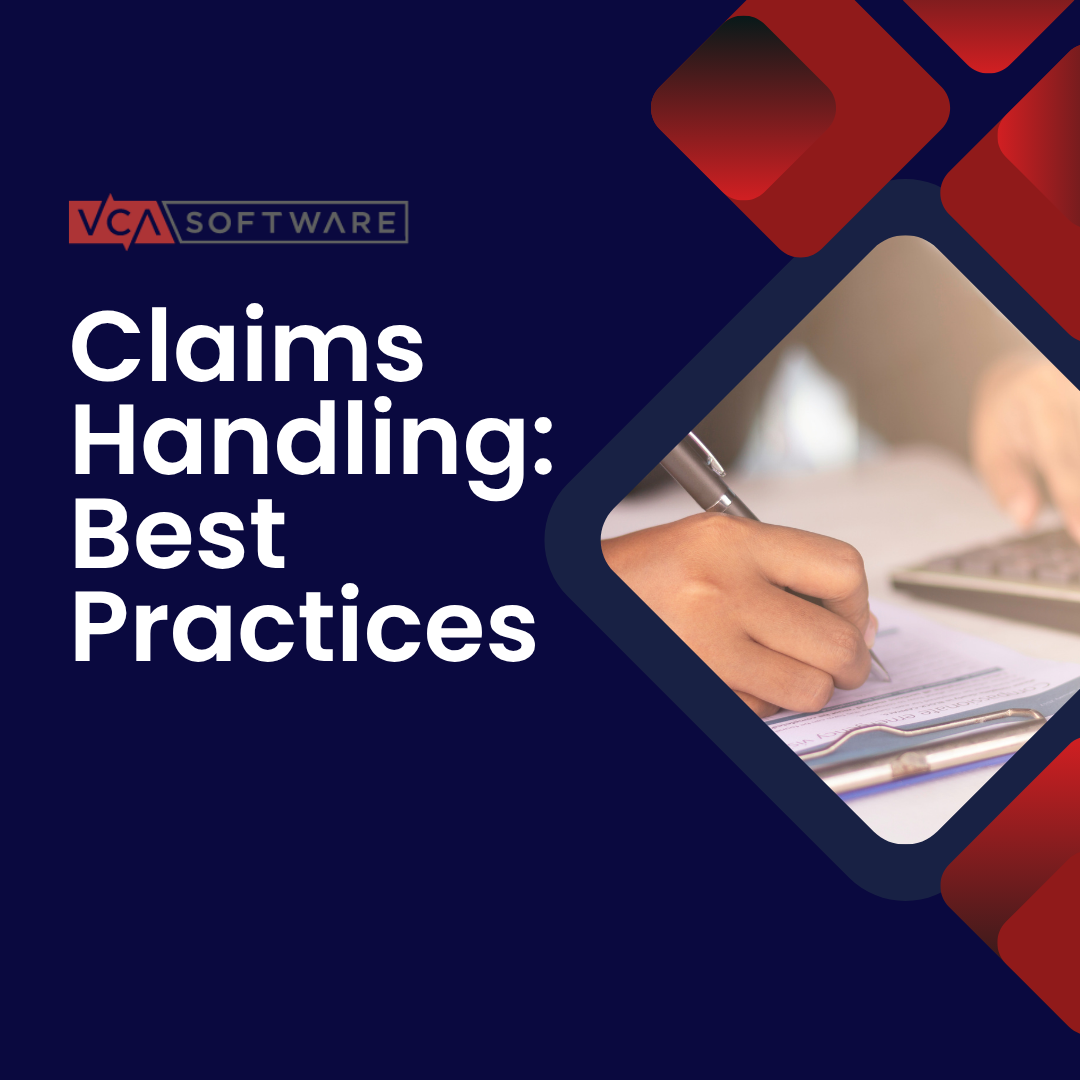Claims handling sits at the heart of the insurance business. It’s where promises made in policies become real actions that help people and businesses recover from losses. But let’s face it – managing claims is rarely straightforward. Between high volumes, manual tasks, and scattered communications, the process often feels harder than it needs to be.
That’s why smart firms are rethinking how they work– not just what they do. This guide breaks down practical ways to improve your claims handling process and how the right tools, like VCA Software, can simplify your workflows, cut down on back-and-forth, and help you deliver faster, better outcomes.
Why Is Improving The Claims Process Important?
When claims are handled well, everyone benefits. Policyholders get faster resolutions during stressful times. Adjusters can manage more claims without burning out. Insurance companies build better reputations and customer loyalty.
Poor claims handling, on the other hand, creates a ripple effect of problems:
- Delayed payments frustrate policyholders
- Backlogs grow larger and more unmanageable
- Errors lead to compliance issues and potential legal exposure
- Staff turnover increases as adjusters feel overwhelmed
A McKinsey study found that improving claims processes can reduce expenses by 25-30% while increasing customer satisfaction by 20%. Those aren’t small numbers.
Key Challenges of Claims Process Improvement
Before diving into solutions, let’s look at what makes claims handling tricky:
- Information gaps: Missing details that slow down assessment and resolution
- Communication breakdowns: Between adjusters, policyholders, and other stakeholders
- Inconsistent processes: Different approaches for similar claims leading to unpredictable outcomes
- Technology limitations: Outdated systems that don’t talk to each other
- Compliance requirements: Keeping up with changing regulations while maintaining efficiency
- Volume fluctuations – Catastrophe events can flood your system with hundreds or thousands of new claims overnight.
- Documentation overload – Each claim generates dozens of documents that need proper filing and retrieval.
- Multiple stakeholders – You’re coordinating between policyholders, repair vendors, medical providers, and internal teams.
- Compliance requirements – Missing deadlines or documentation can create serious regulatory issues.
- Time tracking and billing – Especially for independent adjusters, capturing all billable time accurately is essential, but often cumbersome.
The good news? Each of these challenges has practical solutions.
Strategy 1: Standardize Your Intake Process
The way a claim enters your system sets the tone for everything that follows. Create a consistent intake process that captures all essential information upfront.
Pro tip: Develop a checklist of required information for different claim types. This prevents the back-and-forth of gathering missing details later.
For example, a property claim checklist might include:
- Policy number and effective dates
- Date and time of loss
- Detailed description of damage
- Photos of damaged items/property
- Current contact information for the insured
- Police/fire department reports (if applicable)
Strategy 2: Bring Consistency to Your FNOL Process
First notice of loss (FNOL) sets the tone for the entire claim experience.
What to improve:
- Create clear scripts for gathering information
- Use checklists to ensure all necessary details are collected
- Set expectations about next steps and timing
- Capture contact preferences (email, phone, text)
Pro tip: Record the FNOL call when possible (with permission). This helps resolve any later disputes about what was initially reported and prevents having to ask the policyholder the same questions multiple times.
Strategy 3: Segment Claims by Complexity
Not all claims are created equal. A fender bender doesn’t need the same handling as a multi-vehicle accident with injuries.
Implementation steps:
- Create clear criteria for simple, moderate, and complex claims
- Assign appropriate resources based on complexity
- Use fast-track processes for straightforward claims
- Reserve experienced adjusters for complex cases
Pro tip: Review your segmentation criteria quarterly. Claims that seemed complex six months ago might now be routine as your team gains experience.
Strategy 4: Embrace Digital Documentation
Paper files and scattered emails create delays and confusion. A digital documentation system keeps everything in one place.
Key components:
- Central storage for all claim documents
- Mobile upload options for policyholders
- Automatic indexing and categorization
- Search functionality to quickly find specific information
Pro tip: Create a simple guide for policyholders explaining how to take useful photos of damage. Good photos can dramatically speed up assessment.
Strategy 5: Implement Clear Communication Protocols
Poor communication causes frustration for everyone involved in a claim. Establish clear protocols for keeping all parties informed.
Effective practices:
- Set specific timeframes for initial contact, updates, and decisions
- Use templates for common communications to ensure consistency
- Provide multiple contact channels (phone, email, portal)
- Document all communications in the claim file
Pro tip: After explaining a decision or next step, ask the policyholder to summarize their understanding. This helps identify and clear up misunderstandings immediately.
Strategy 6: Use Data to Drive Process Improvement
Data helps you spot patterns, identify bottlenecks, and measure the impact of process changes.
Focus areas:
- Average time to resolution by claim type
- Touch points per claim
- Adjuster workloads and outcomes
- Customer satisfaction scores
- Reopened claim rates
Pro tip: Don’t just collect data – schedule regular reviews with your team to discuss findings and brainstorm improvements. The people handling claims daily often have the best insights.
Strategy 7: Support (and Retain) your Adjusters
Well-trained adjusters make better decisions faster. Ongoing training keeps skills sharp and morale high.
Training elements:
- Technical skills (policy interpretation, damage assessment)
- Soft skills (customer service, negotiation)
- System proficiency
- Regulatory updates
Pro tip: Create a mentorship program pairing experienced adjusters with newer team members. This builds institutional knowledge transfer into your daily operations.
Strategy 8: Automate Routine Tasks
Automation frees up human attention for tasks that require judgment and expertise.
Automation opportunities:
- Assignment and routing of new claims
- Status updates to policyholders
- Document generation
- Payment processing
- Reminder notifications
Pro tip: Start small with automation. Choose one process, automate it well, measure the results, then move to the next opportunity.
Strategy 9: Implement Quality Control Checks
Quality control catches errors before they become problems and identifies training opportunities.
Effective QC practices:
- Random file reviews by supervisors
- Peer reviews for complex claims
- Checklists for important decision points
- Regular audits of closed files
Pro tip: Make quality control a positive experience by highlighting what was done well along with areas for improvement. This builds a culture of excellence rather than fear.
Strategy 10: Strengthen Your Vendor and Adjuster Networks
External partners like repair shops, medical providers, and contractors significantly impact claim outcomes.
Network management:
- Establish clear performance expectations
- Regularly review vendor quality and costs
- Create preferred provider lists for common services
- Build relationships with key vendors
Pro tip: Schedule quarterly reviews with your most-used vendors to discuss ways to improve collaboration. These partnerships can yield significant efficiency gains.
Strategy 11: Use Claims Software Built for the Real World
Most systems force you to change how you work. VCA flexes to match your actual workflows– from Lloyd’s reporting to time tracking to delegated authority oversight. Look for solutions that:
- Automate routine communications
- Provide reminders for important deadlines
- Offer mobile access for field adjusters
- Integrate time tracking with billing
- Store documents securely with easy retrieval
Pro tip: When evaluating claims software, focus on ease of use. The best system is one your team will actually use consistently.
Strategy 12: Develop a Consistent File Documentation System
Well-organized claim files save time and reduce errors. Establish naming conventions and folder structures that make sense for your team.
Pro tip: Include the date in document names (YYYY-MM-DD format) to ensure chronological sorting.
For example:
- 2023-05-15_Initial_Inspection_Report.pdf
- 2023-05-20_Contractor_Estimate.pdf
- 2023-06-01_Payment_Authorization.pdf
Implementing These Strategies: Where to Start?
Feeling overwhelmed by all these potential improvements? Here’s how to begin:
- Assess your current state: What’s working well? Where are the pain points?
- Prioritize: Which improvements would have the biggest impact with reasonable effort?
- Start small: Pick one or two strategies to implement first
- Measure results: Establish baseline metrics before making changes
- Adjust and expand: Use what you learn to refine your approach
Remember that improvement is a journey, not a destination. The most successful claims operations continuously evolve their processes.
Measuring Improvement in Claims Handling
How do you know if your changes are working? Track these key metrics:
Cycle time – The average days from first notice of loss to claim closure
Touch time – How many times a file needs to be handled before resolution
Reopening rate – Percentage of claims that need to be reopened after closing
Customer satisfaction – Measured through surveys or feedback forms
Billing accuracy – Percentage of invoices submitted without errors or disputes
The Role of Claims Management Software
Modern claims management software like VCA can be the backbone of your improvement efforts. The right platform integrates many of the strategies we’ve discussed:
- Standardized intake processes
- Digital documentation
- Automated workflows
- Communication tools
- Analytics and reporting
- Mobile capabilities
When evaluating software options, look beyond features to how the system will support your specific process improvement goals.
Real-World Example: Independent Adjuster Firm Transformation
A mid-sized independent adjusting firm was struggling with inconsistent processes across their team of 15 adjusters. Each adjuster had their own system for tracking deadlines, documenting claims, and communicating with clients.
The solution:
- They implemented a cloud-based claims platform that standardized workflows
- Created client-specific templates for common communications
- Set up automated reminders for SLA deadlines
- Enabled mobile time tracking for field adjusters
The results:
- Average claim handling time decreased by 22%
- Billing disputes dropped by 35%
- Adjusters could handle 15-20% more claims with the same effort
- Client retention improved as reporting became more consistent
Final Thoughts
Improving claims handling isn’t just about technology or processes – it’s about people. The best systems still need skilled professionals making judgment calls and providing empathetic service.
As you implement changes, keep your team engaged in the process. Their buy-in and feedback are crucial to success. After all, they’re the ones who turn these strategies into real-world results for your policyholders.
What’s your biggest claims handling challenge? Start there, apply these strategies, and watch how small improvements add up to significant results.
Ready to modernize your claims operations? Ask for a product tour of VCA or try our ROI calculator to estimate your time savings.
|
Rob Ogle is a Customer Success executive with 20+ years of experience in insurance and SaaS. He’s built and led high-performing success, support, and sales teams at multiple software companies, driving retention, growth, and customer satisfaction. Rob specializes in scaling success programs, aligning customer outcomes with business goals, and leading cross-functional initiatives in dynamic, high-growth environments. |

 Rob Ogle
Rob Ogle



